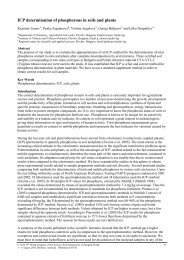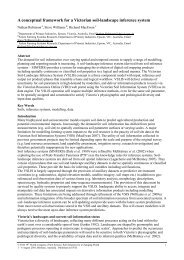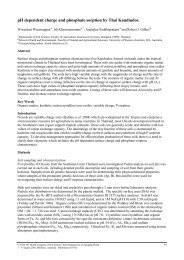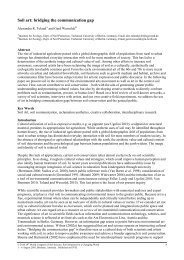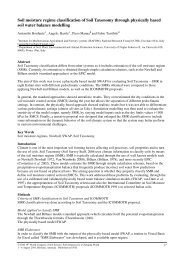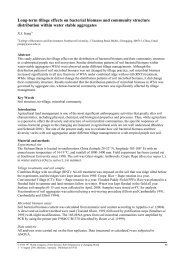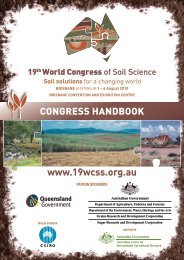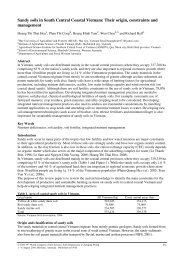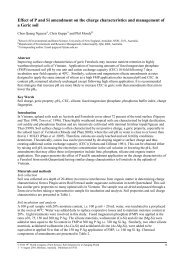You also want an ePaper? Increase the reach of your titles
YUMPU automatically turns print PDFs into web optimized ePapers that Google loves.
Effect of rice straw application on hydrolytic enzyme activities in Chinese paddy<br />
soils<br />
<strong>Beke</strong> <strong>Gredner</strong> A and Rolf Tippkötter A<br />
A Institute of Soils Science, University of Bremen, Germany, Email: bgredner@uni-bremen.de<br />
Abstract<br />
The cultivation of rice (Oryza sativa L.) produces large quantities of straw. Although the burning of straw is<br />
illegal it is a commonly used method of rice straw management in China, causing a series of problems. An<br />
alternative is the incorporation of rice straw into the soil.<br />
In this study different rice straw management practices were simulated in a microcosm experiment under<br />
controlled conditions in a climate chamber. The decomposition of incorporated straw and straw ash was<br />
determined by monitoring the hydrolysis of polysaccharides by extracellular enzyme activities. As a result,<br />
the actual hydrolytic activity, the cellulose-induced activity as well as the xylan-induced activity caused by<br />
rice straw decomposition indicate significant differences between two investigated soils of the regions Wujia<br />
and Jinjiaba (Jiangsu Province, China).<br />
Key Words<br />
Soil enzymes, rice straw management, paddy soils, microcosms<br />
Introduction<br />
The cultivation of rice produces large quantities of straw, as an agricultural waste, ranging from 2 - 9 t/ha<br />
world wide. In many countries the traditional management practice of post harvest rice residues is the<br />
elimination of straw by open-air burning (Becker et al. 1994; Cao et al. 2008). Although this includes<br />
advantages such as disease and pest control (Ponnamperuma 1984), disadvantages related to the release of<br />
greenhouse gases and the production of particulate matter are obvious (Cao et al. 2008). Therefore, as an<br />
alternative to burning of straw the incorporation into the soil stands to reason, which has been widely<br />
accepted (Cassman and Pingali 1995), although it may reduce yields (Cassman et al. 1995). In contrast to<br />
straw of wheat or barley the main components of rice straw are cellulose and hemicellulose, encrusted by<br />
lignin in addition to only small amounts of proteins. Consequently, it is very resistant to microbial<br />
decomposition compared to other cereals (Parr et al. 1992).<br />
The soil enzyme activities are supposed to be direct expressions of the soil microbial community which is<br />
required for the metabolic transformation of the organic substances added to the soil and the nutrients<br />
supplied by the soil itself (Caldwell 2005). Since decomposition of plant residues is accompanied by<br />
extracellular enzymes such as cellulases and xylanases, the activity of these can act as a reliable indicator of<br />
decomposition (Stemmer et al. 1999). In addition, several studies have shown that the enzyme activity can be<br />
used as an early indicator for changes in soil soil properties initiated by soil management practices (e.g. Dick<br />
1992; Lal et al. 1998).<br />
The intension of this research is to evaluate the effect of rice straw and straw ash in paddy soils of different<br />
texture on the activities of hydrolytic enzymes, cellulases and xylanases. The study was carried out under<br />
controlled conditions in a microcosm experiment according to Eickhorst and Tippkötter (2009).<br />
Materials and Methods<br />
Soils<br />
The microcosm experiment was set up in a climate chamber with two different soils from the Jiangsu<br />
Province, China: a. Gleyic Fluvisol (Wujia, WU), and b. Stagnic Anthrosol (Jinjiaba, JI). The soils were<br />
analysed for selected physical and chemical characteristics, presented in Table 1. Samples were incubated in<br />
microcosms (15 cm in diameter, height 25 cm), filled with an artificial plough pan of about 3 cm thickness<br />
(Db 1.4-1.6 g/cm³) and a puddled Ap-horizon of 14 cm height. Climatic conditions were simulated according<br />
to the mean temperatures of the original location during the rice growing period with a night to day ratio of<br />
13.5 to 10.5 hours.<br />
© 2010 19 th World Congress of Soil Science, Soil Solutions for a Changing World<br />
1 – 6 August 2010, Brisbane, Australia. Published on DVD.<br />
13
Table 1. Physical and chemical properties of the investigated soils.<br />
Location Texture Sand Silt Clay pH<br />
(WRB)<br />
[%]<br />
(CaCl2)<br />
© 2010 19 th World Congress of Soil Science, Soil Solutions for a Changing World<br />
1 – 6 August 2010, Brisbane, Australia. Published on DVD.<br />
EC<br />
[µS/cm]<br />
Wujia Silty<br />
loam<br />
27.1 64.2 8.7 6.3 268 1.23 11.1<br />
Jinjiaba Silty clay 0.9 58.1 41.0 5.1 418 1.88 10.9<br />
Plants and straw application<br />
The two soils were planted with irrigated short period rice (Oryza sativa L., type Japonica, cultivar 中选 181<br />
(Zhong Xuan 181), vegetation period 90 days after transplanting (DAT), two plants per microcosm).<br />
Four scenarios of straw application have been chosen:<br />
A Rice Rice straw 8 t/ha dry matter<br />
B No plants Rice straw 8 t/ha dry matter<br />
C Rice Rice straw ash 8 t/ha straw dry matter<br />
D Rice No plant residues<br />
Plant residues were incubated directly before transplanting of rice to simulate intensive cropping.<br />
Fertilization was held at equal levels for all variants. The soils were under submerged conditions until DAT<br />
112, and subsequently drained for two weeks.<br />
Sample collection<br />
Soil samples for the analysis of enzymes were taken from the whole soil profile randomly and analysed<br />
photometrical for a) actual hydrolytic activity (act. hyd.) according to Boschker et al. (1995) with<br />
modifications as incubation temperature (40°C) and time (16 hours) are concerned, b) cellulose-induced<br />
activity (cell.-ind.) according to Hope and Burns (1987) and c) xylan-induced activity (xyl.-ind.) similar to<br />
the method of cellulose-induced activity (according to Hope and Burns (1987); modified). The hydrolysis<br />
under actual and substrate-saturated conditions was measured by the release of monosaccharides after<br />
inhibition of microbial uptake with a the determination of the produced reducing sugars according to Lever<br />
(1973).<br />
The frequency and time of sampling of the enzymes was due to the plant development stages with a high<br />
sampling density at the beginning and the end of the vegetation period.<br />
Statistical analysis<br />
Statistical analysis was performed using SPSS software (SPSS Inc., 2008). All data were expressed as mean<br />
values including the standard deviation. Statistical significance of the treatment effects was established by<br />
the analysis of variance (ANOVA; Kruskal-Wallis) and the comparison of means. Levels of probability were<br />
5% (*), 1% (**) and 0.1% (***), respectively.<br />
Results<br />
Enzyme activities, expressed as mg glucose produced per g soil (dry matter) and hour are presented in Figure<br />
1. The results of the analysis of variance are given in Table 2.<br />
The actual hydrolytic activity showed maximum values during the first week after transplanting with highest<br />
values in the straw incubated variants (A, B). From DAT 21 on the values decreased and stayed at a constant<br />
level until harvest. Over the vegetation period the actual hydrolytic activity of JI (clayey soil) was higher<br />
than WU (sandy soil).<br />
The cellulose-induced activities in the soil WU showed significant strong correlations to the time, but there<br />
was no influence of the straw treatment. In contrast, the soil JI showed significant differences between the<br />
variants but not with the time. The cellulose-induced activities of both soils were not subjected to significant<br />
fluctuations during the vegetation period. The xylan-induced activities were similar to the cellulose-induced<br />
activities, but resulted in higher values of activity, especially of the straw treated variants (A, B). Differing<br />
from the other enzyme activities, the xylan-induced activity was similar in both investigated soils.<br />
Ct<br />
[%]<br />
C:N<br />
14
Table 2. Results of the analysis of variance. Effect of the investigated soils, the variants of treatment, and the<br />
days after transplanting on the enzyme activities.<br />
Location Act.hyd. Cell.-ind. Xyl.-ind.<br />
Soils *** *** n.s.<br />
Wujia<br />
Variant<br />
DAT<br />
n.s.<br />
n.s.<br />
n.s.<br />
***<br />
n.s.<br />
***<br />
Jinjiaba<br />
Variant<br />
DAT<br />
n.s.<br />
**<br />
**<br />
n.s.<br />
***<br />
n.s.<br />
(DAT: days after transplanting, Act.hyd.: actual hydrolytic activity, Cell.-ind.: cellulose-induced activity, Xyl.ind.:<br />
xylan-induced activity; n.s.: not significant, *: significant with p = 0.05, **: significant with p = 0.01,<br />
***: significant with p = 0.001)<br />
Figure 1. Results of investigated enzyme activities during the vegetation period.<br />
(DAT: days after transplanting)<br />
Discussion<br />
The actual release of reducing sugars was increased by the addition of rice straw to soil especially in the silty<br />
clay. This is reasonable since rice straw is a natural substrate for microorganisms in rice field soil (Stemmer<br />
et al. 1999) and is presumably caused by the presence of easily decomposable carbohydrates. From DAT 21<br />
on there was no difference between the diverse straw treatments in both soils and the decomposition of<br />
polysaccharides was apparently limited by the availability of carbohydrates. Constant levels of carbohydrates<br />
were presumably accessible and the remaining were subjected to only little changes during the vegetation<br />
period.<br />
The cellulose and xylan induces activities displayed higher values compared to the actually hydrolytic<br />
activity. This presumably indicates the decomposition of polysaccharides was limited rather by the<br />
accessibility of substrate than by the availability of enzyme activity. Hence, for the sandy soil WU an impact<br />
of incorporated straw on the enzyme activity could not be detected, but the clayey soil JI presented a strong<br />
correlation to the application of straw.<br />
© 2010 19 th World Congress of Soil Science, Soil Solutions for a Changing World<br />
1 – 6 August 2010, Brisbane, Australia. Published on DVD.<br />
15
The gradually increasing xylan-induced activity of JI is in accordance to Stemmer et al. (1999), who found<br />
that straw amendment can stimulate enzyme activities a microbial biomass with varying effects for different<br />
enzymes.<br />
Differences of enzyme activities between the both soils occur presumably because of many factors, including<br />
texture, organic matter content, and nutrient composition of the soils. Hence may free enzymes complex with<br />
humic colloids and may be stabilized on clay surfaces and organic matter, especially in the clayey soil (JI),<br />
which results in higher activities.<br />
Conclusion<br />
The incorporation of rice straw or straw ash into paddy soils revealed texture dependent differences of<br />
enzyme activities. Straw induced effects are only detectable in the clayey soil. The reaction of the enzymes<br />
to the diverse treatments (addition of straw, straw ash, planting) is different.<br />
The varying response of the investigated enzyme activities showed that the enzymes are influenced by<br />
various soil properties and therefore are not qualified as early indicators for management induced changes in<br />
soil properties.<br />
References<br />
Becker M, Ladha JK, Ottow JCG (1994) Nitrogen losses and lowland rice yield as affected by residue<br />
nitrogen release. Soil Science Society of America Journal 58, 1660-1665.<br />
Boschker HTS, Bertilsson SA, Dekkers EMJ, Cappenberg TE (1995) An inhibitor-based method to measure<br />
initial decomposition of naturally occurring polysaccharides in sediments. Applied and Environmental<br />
Microbiology 61(6), 2186-2192.<br />
Caldwell BA (2005) Enzyme activities as a component of soil biodiversitiy: A review. Pedobiologia 49, 637-<br />
644.<br />
Cao GL, Zhang XY, Wang YQ, Zheng FC (2008) Estimation of emissions from field burning of crop straw<br />
in China. Chinese Science Bulletin 53(5), 784-790.<br />
Cassman KG, De Datta SK, Olk DC, Alcantara J, Gamson M, Descalsota J, Dizon M (1995) Yield decline<br />
and nitrogen economy of long-term experiments on continuous irrigated rice systems in the tropics. In<br />
'Soil Management: Experimental Basis for Sustainability and Environmental Quality'. (Eds R Lal, BA<br />
Stewart) pp. 181-222. (CRC Press, Boca Raton, Florida).<br />
Cassman KG, Pingali PL (1995) Intensification of irrigated rice systems learning from the past to meet future<br />
challenges. Geo Journal 35, 299-305.<br />
Eickhorst T, Tippkötter R (2009) Management-induced structural dynamics in paddy soils of South East<br />
China simulated in microcosms. Soil and Tillage Research 102, 168-178.<br />
Glissmann K, Conrad R (2002) Saccharolytic activity and its role as a limiting step in methane formation<br />
during the anaerobic degradation of rice straw in rice paddy soils. Biology and Fertility of Soils 35, 62-<br />
67.<br />
Hope CFA, Burns RG (1987) Activity, origins and location of cellulases in a silt loam soil. Biology and<br />
Fertility of Soils 5, 164-170.<br />
Lever M (1973) Colorimetric and fluorometric carbohydrate determination with p-hydroxybenzoic acid<br />
hydrazide. Biochemical Medicine 7, 274-281.<br />
Parr JF, Papendick RI, Hornick SB, Meyer RE (1992) Soil quality: attributes and relationships to alternative<br />
and sustainable agriculture. American Journal of Alternative Agriculture 7, 5-11.<br />
Ponnamperuma FN (1984) Straw as a source of nutrients for wetland rice. In 'Organic matter and rice'.<br />
(IRRI) pp. 117-137. (IRRI, Los Banos, Philippines).<br />
Stemmer M, Gerzabek MH, Kandeler E (1999) Invertase and xylanase activity of bulk soil and particle-size<br />
fractions during maize straw decomposition. Soil Biology and Biochemistry 31, 9-18.<br />
© 2010 19 th World Congress of Soil Science, Soil Solutions for a Changing World<br />
1 – 6 August 2010, Brisbane, Australia. Published on DVD.<br />
16



